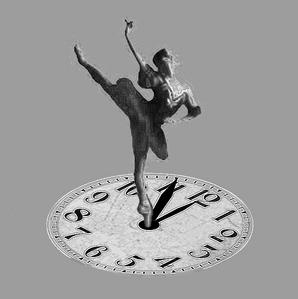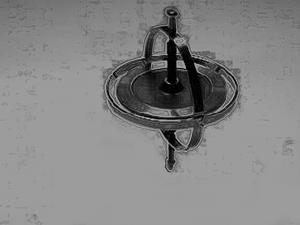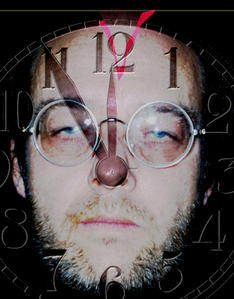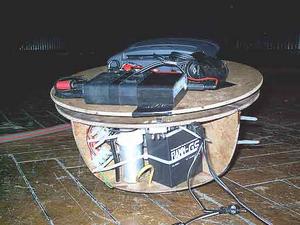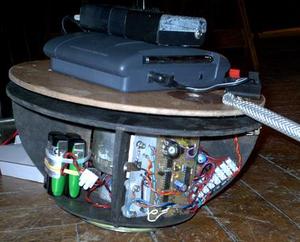Borut Savski - tretja od treh miniatur iz serije Zvok kot metafora
Borut Savski - third of three miniatures from the series Sound as Metaphore
Dancer / Plesalec
Dancer was presented at Kapelica Gallery/ Ljubljana on 17th of February, after a delay of a week, when an uncontrollable rotation tear out the object's guts.
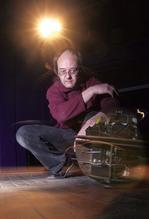 |
This photo by Miha Fras accompanied the article on the "one of the most poor performances" of machines that ever happened at Kapelica Gallery. Written by Jaša Kramaršič at Mladina. His is also the thesis that "object should be able to speak on it's own..." |
|
The robot must be perfectly stable on it's own (now OK), a better speed control added (OK, done), lowering of the weight (Litium instead of Pb accus - done, YES...). Apart from disbalance control (for changing the direction) also some form of selfbalance control must be added. Disbalancing must have priority over the self-balancing until some moment, then the two must change priorities. One comment though: It came to my mind that the description of the object as "robot" was not originally mine. It was also called "android", which is little better denotation, since it alludes that a moving object is a metaphore of human. This is the most precise term: a moving object as a metaphore. Why not robot or android? Because these terms define the functionality of machine. I caught myself thinking at one moment that the thing should really see the surroundings and be able to decide intelligently. But this is going too far... sound excerpts... mp3s: Plesalec/ Dancer was produced by Kapelica Gallery with the help of Ministry of Culture of Slovenia and City of Ljubljana. |
|
|
|
|
|
|
It is fitted with a tail (as seen on the right). Tail helps to keep the upper part relatively fixed, so that all the spin is transfered to the lower part. It still doesn't have a sound sensitive counterbalance to change direction (now the tail helps). The batteries and the rough grounds allow for about 15 minutes of "autonomy" ... |
The next (last?) version will be "production version" with a nickname Rudi (-> Rudolf Nurejev, of course...). I'll fix some kind of colorful panties for it. The tail will eventually have to get off, if any kind of "subjectivity" is to emerge (I think). Humans balance themselves with abstract counterweights - not with tail ... |
|
PLESALEC/ PLESALKA Plesalec je avtonomen gibljiv objekt, ki se želi predstaviti kot umetniški subjekt. Deluje na principu plesa/ pomikanja skozi zvočno polje v prostoru. Njegov komunikacijski kanal (-> višji smisel; motiv) je torej zvok, ki ga vodi sem ter tja po prostoru. A ker gre že za abstrakcijo (primarni motiv je gibanje; posledični motiv, ki ga želimo, pa je zvok - vmes je neka točka potujitve, ki pa jo določimo/ osmislimo ljudje). Šele ko se neposredno razumevanje vzrokov (višjega) gibanja (-> tokrat zvok) zabriše - torej se samo gibanje kot neposredni (čeprav nelinearni - ne neposredno soodvisen/soodgovoren) vzrok umakne v ozadje - objekt "zaživi" samostojno življenje. Ta način nastajanja in osamosvajanja miselnih teles je enak kot pri mitih. Mit je miselno telo, ki se je (pomensko) osamosvojilo (postalo verjetno - torej resnično) s tem ko je izgubilo svoje vzročne povezave. Mit ne potrebuje posebnega procesa razumevanja - kot nosilec pomena je neposredno razumljiv. Pri mitu so vzroki zabrisani. Če bi jih znova prepoznali, bi mit razpadel. Temu pravimo demistifikacija.
Seveda gre tudi tokrat za metaforično postavitev. Bistveno vprašanje, ki si ga postavljam je, ali ni morda človeku subjektivnost dosegljiva zaradi gibanja (v splošnem: dinamike) in ne (le) zaradi jezika?
Razcep, v psihoanalizi poimenovan manko, onemogoča statično stabilno stanje (-> trajno srečo, trajno nesrečo). Ali pa ni morda prav ta razcep motor, generator sprememb? V takem primeru so tudi odločitve (racionalizirane spremembe) lahko dokaj poljubne (odvisne od inercij - tudi in predvsem psiholoških - vsakega individualnega sistema).
Še o racionalizaciji:
Vprašanje Plesalca je torej lovljenje dinamičnega ravnovesja - najbrž ni izključeno tudi padanje. Plesalec lovi ravnovesje na način vrtavke, za spreminjanje smeri plesa pa mu pomaga spreminjanje položaja težiščnice od ravnovesne lege. Za relativno mirovanje težiščnice skrbi giroskop - nujno potrebni (inercijski) element. Uspešnost lovljenja ravnotežja je potreben pogoj za nastanek zvočne kompozicije.
|
DANCER
Dancer is an autonomous moving object that tries to present itself as an artistic subject. It functions on the principle of movement through the sound field in the gallery space. It's communication channel (-> the higher meaning, sense; -> the motive) is therefore the sound. The sound takes the object here & there accross the space. But the sound as motive is already an abstraction (-> a human translation/ intervention). Primary motive is the motion, the secondary (-> higher) motive is transformed to sound (since we want it to be so...). Somewhere in-between was a moment of estrangement - a change of evaluation system. Since the sound is (nonlineary) linked to movement, this change is not very big, but it should allow the object to achieve the "artistic purpose".
Of course, it is again a metaphorical installation. The question now is: is it possible that the subjectivity in human has something to do with the movement (with dynamics, in general) and not (just) the language?
movement -> motive (-> motion)
A female reconvalescent after a serious accident, when she had a total amnesia, told that she had a lot more problem with the learning of walking (balancing), then with the language. The above question is more feasible, if we broaden the physical balancing also to the psychologic balancing, where in everyday life we experience less control.
The split, in psychoanalysis called lack (fr.: manque), prohibits the static stable state (-> everlasting happiness, everlasting misery...). Is it not this split that is a motor (-> a motivator), the generator of changes? In such case also decisions (-> the rationalized changes) become fairly arbitrary (dependent upon the inertia - also & especially the psychologic ones - of each individual system).
About rationalization:
The question about the Dancer is therefore the realtime dynamic balancing - probably also the falling down. The Dancer balances in the manner of a gyro, to change the direction it uses the change of the vector of object's weight (gravitation) vector from the balanced (null) position. For the relative stable position of the gravitation vector we use gyroscope - which is the necessary inertial element. The succesful act of dynamic balancing is the necessary attribute for an emergence of a musical composition. |
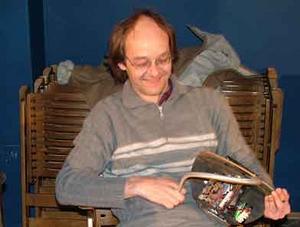 "... nothing is easy" is a citation from a movie by Pedro Almodovar, when Pina Bausch performs one of her very special moves ... and it's coming to my mind often lately ...
"... nothing is easy" is a citation from a movie by Pedro Almodovar, when Pina Bausch performs one of her very special moves ... and it's coming to my mind often lately ...